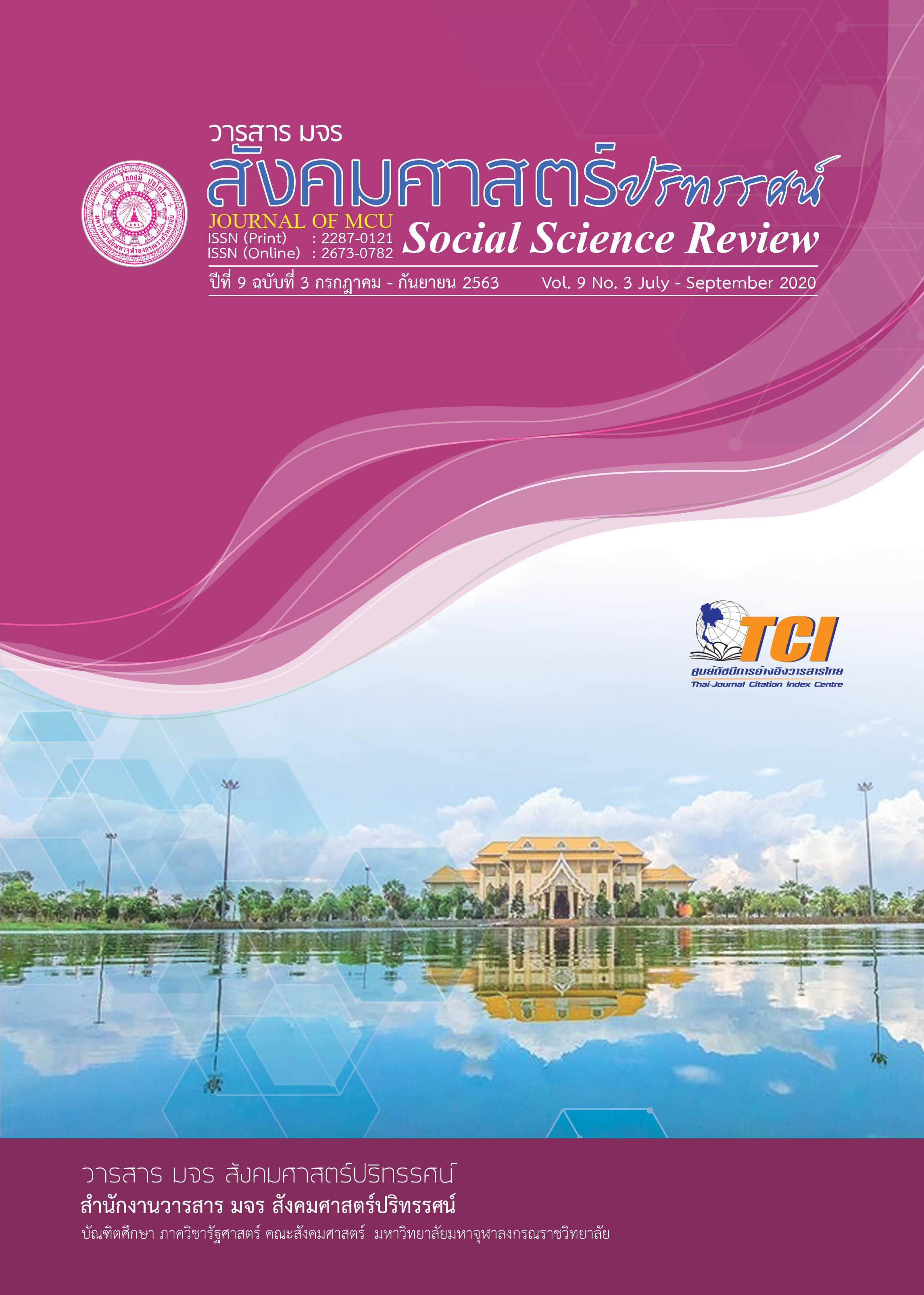การจัดการเศรษฐกิจชุมชนในจังหวัดระยอง
คำสำคัญ:
Management, Community Economy, Rayong Provinceบทคัดย่อ
บทความวิจัยนี้มีวัตถุประสงค์เพื่อ 1. ศึกษาการจัดการเศรษฐกิจชุมชนในจังหวัดระยอง 2. ศึกษาปัจจัยที่มีผลต่อการจัดการเศรษฐกิจชุมชน และ 3. เสนอสำหรับการจัดการเศรษฐกิจชุมชนในจังหวัดระยอง โดยใช้วิธีการวิจัยแบบผสานวิธี การวิจัยเชิงปริมาณเก็บข้อมูลด้วยแบบสอบถามที่มีค่าความเชื่อมั่นที่ 0.969 จากกลุ่มตัวอย่าง 378 คน เลือกแบบเจาะจง จากผู้ซื้อสินค้าโอทอป วิเคราะห์ข้อมูลด้วย ความถี่ ร้อยละ ค่าเฉลี่ย ค่าเบี่ยงเบนมาตรฐาน การวิจัยเชิงคุณภาพ เก็บข้อมูลจากผู้ให้ข้อมูลหลัก 20 คน เลือกแบบเจาะจง ด้วยการสัมภาษณ์เชิงลึกแบบตัวต่อตัว และจากผู้มีส่วนร่วมในการสนทนากลุ่มเฉพาะอีก 10 คน วิเคราะห์ข้อมูลด้วยการพรรณนาความ ผลการวิจัยพบว่า เศรษฐกิจชุมชนในจังหวัดระยองได้แก่สินค้าโอทอปเป็นสินค้าที่ได้รับความนิยมสูงสุดและสร้างรายได้ให้กับชุมชนจากนักท่องเที่ยวที่มาท่องเที่ยวชายทะเลและสวนผลไม้ในฤดูกาล แต่จังหวัดระยองยังขาดการบริหารเศรษฐกิจชุมชนเช่น การจัดตั้งคณะกรรม การดูแลคุณภาพของผลิตภัณฑ์ การตลาด การประชาสัมพันธ์และการประสานงานกับหน่วยงานทั้งภาครัฐและเอกชน ส่วนปัจจัยที่มีผลต่อการจัดการเศรษฐกิจชุมชนในจังหวัดระยองมี 5 ประการ คือ 1) งบประมาณประจำปีสำหรับการจัดการและพัฒนาเศรษฐกิจชุมชน 2) คุณภาพของผลิตภัณฑ์ 3) บุคลากรได้รับการพัฒนาอย่างต่อเนื่อง 4) การจัดการที่มีแผนธุรกิจประจำปี และ 5) ปาปาณิกธรรม 3 คือ จักขุมามีวิสัยทัศน์ วิธูโร บริการจัดการดี และนิสสยสัมปันโณ มีมนุษย์สัมพันธ์ดี มีเครดิตดี ส่วน วิธีการที่เหมาะสมสำหรับการจัดการเศรษฐกิจชุมชนในจังหวัดระยองได้แก่การบริหารแบบ 4M’s ได้แก่บุคลากร งบประมาณ วัตถุดิบ และ การจัดการบูรณาการกับ ปาปณิกธรรม 3 สองส่วนนี้บูณรณาการเข้าด้วยกันกลายเป็นรูปแบบการจัดการเศรษฐกิจชุมชนในจังหวัดระยองที่มีประสิทธิภาพ
เอกสารอ้างอิง
Gibson-Graham, J.K. (1996). The End of Capitalism (As We Knew It): A Feminist Critique of Political Economy. Oxford: Blackwell.
Hiramatsu, M. (2019). The One Village One Product Movement. Retrieved January 9, 2019, from www.iovoppa.org/files/OVOP.doc
Shragge, E. (2003). The Politics of Community Economic Development. In E. Shragge Ed. Community Economic Development: In Search of Empowerment and Alternatives. Montreal: Black Rose Books.
Rayong province. (2019). [Online]. Source: https://th.wikipedia.org/wiki [10 January 2019].
Reintjas, C. (2019). What Is Solidarity Economy. Retrieved January 9, 2019, from http://www.zcommunications.org/what-is-a-solidarity-economy-by-carola-reintjes
The Community Economies Collective. (2019). Retrieved January 9, 2019, from http://sites.tufts.edu/foodeconomyfinalreport/files/2013/04/ Community-Economy.pdf
ดาวน์โหลด
เผยแพร่แล้ว
รูปแบบการอ้างอิง
ฉบับ
ประเภทบทความ
สัญญาอนุญาต
ลิขสิทธิ์ (c) 2020 วารสาร มจร สังคมศาสตร์ปริทรรศน์

อนุญาตภายใต้เงื่อนไข Creative Commons Attribution-NonCommercial-NoDerivatives 4.0 International License.
เพื่อให้เป็นไปตามกฎหมายลิขสิทธิ์ ผู้นิพนธ์ทุกท่านต้องลงลายมือชื่อในแบบฟอร์มใบมอบลิขสิทธิ์บทความให้แก่วารสารฯ พร้อมกับบทความต้นฉบับที่ได้แก้ไขครั้งสุดท้าย นอกจากนี้ ผู้นิพนธ์ทุกท่านต้องยืนยันว่าบทความต้นฉบับที่ส่งมาตีพิมพ์นั้น ได้ส่งมาตีพิมพ์เฉพาะในวารสาร มจร สังคมศาสตร์ปริทรรศน์ เพียงแห่งเดียวเท่านั้น หากมีการใช้ภาพหรือตารางหรือเนื้อหาอื่นๆ ของผู้นิพนธ์อื่นที่ปรากฏในสิ่งตีพิมพ์อื่นมาแล้ว ผู้นิพนธ์ต้องขออนุญาตเจ้าของลิขสิทธิ์ก่อน พร้อมทั้งแสดงหนังสือที่ได้รับการยินยอมต่อบรรณาธิการ ก่อนที่บทความจะได้รับการตีพิมพ์ หากไม่เป็นไปตามข้อกำหนดเบื้องต้น ทางวารสารจะถอดบทความของท่านออกโดยไม่มีข้อยกเว้นใดๆ ทั้งสิ้น





